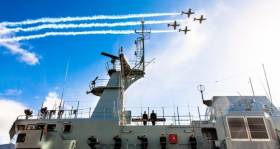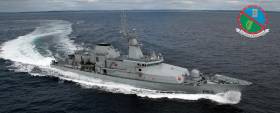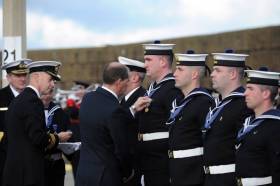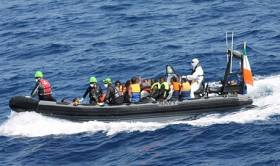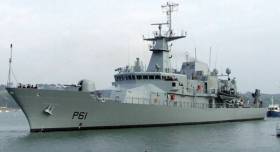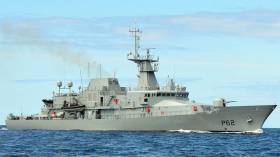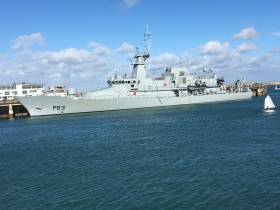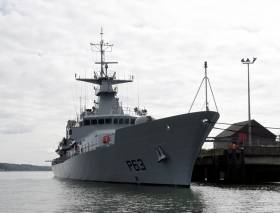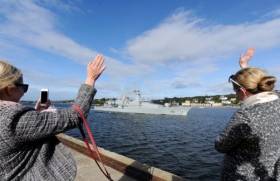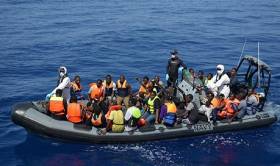Displaying items by tag: Navy
#HospitalShip - The Naval Service have plans for a newbuild which would be equipped to provide full medical facilities at sea have been endorsed by Taoiseach Enda Kenny.
The Irish Times writes that a White Paper on Defence promises a multi-purpose vessel equipped with a fully functioning hospital, Mr Kenny said in Galway docks on Monday.
This would allow medical personnel to serve in “war and conflict situations”, Mr Kenny said. He was speaking at the commissioning of the Naval Service’s latest new patrol ship, LÉ William Butler Yeats.
Mr Kenny said it was “his wish” that such a multi-purpose ship – still at pre-design stage – would be built to serve in humanitarian crises. It was in “keeping with our rich tradition of charity and volunteering”, he said.
For more on search and rescues in the Mediterranean and the ceremony for the newbuild held at Galway Port, click here.
LÉ William Butler Yeats Formally Commissioned Into Naval Service
#OPV90named - A new Irish Naval Service vessel costing in the region of €66m has been formally commissioned at a ceremony in Galway Port, reports RTE News.
After an address by the Taoiseach at Galway Harbour yesterday, the LÉ William Butler Yeats (P63) was officially named by a granddaughter of the poet, Caitriona Yeats.
The formal commissioning followed, before Lieutenant Commander Eric Timon led the crew aboard.
The LÉ William Butler Yeats replaces the LÉ Aisling in the naval fleet, after the latter was decommissioned last May.
Afloat adds that the third OPV90 class newbuild built by Babcock Marine, Appledore in the UK had paid a visit to Dun Laoghaire Harbour in late September.
She follows leadship LÉ Samuel Beckett and LÉ James Joyce, also completed by the north Devon shipyard. In recent weeks this pair switched deployment duties in providing humanitarian operations in the Mediterranean Sea.
Medal for Navy Service Personnel On Humanitarian Operations Abroad
#Medals - Personnel from Irish Defence Forces writes RTE, who have taken part in humanitarian operations abroad have been presented with a new medal in Rosslare Harbour.
Minister of State with special responsibility for Defence Paul Kehoe presented the new international operational service medals at a ceremony on Saturday (15 October) in the Co Wexford port.
Troops who were deployed to counter the Ebola crisis in Sierra Leone and naval personnel who helped rescue over 3,000 people in the Mediterranean last year received the award.
Among those receiving medals today were 54 members of the permanent Defence Force who served on board the Irish Naval Service flagship LÉ Eithne from May to July in 2015.
Also awarded the medal were five members of the Army personnel who served in Sierra Leone fight against Ebola.
This was the first of a number of similar ceremonies which will be held around the country.
Recently Deployed LÉ Samuel Beckett Rescues Migrants
#MigrantRescue - The Naval Service recently deployed LÉ Samuel Beckett, located and rescued a total of 130*migrants yesterday during a search and rescue (SAR) operation. The rescue took place 22 nautical miles NE of Tripoli, Libya.
The rescue operation arose from a request from the Italian Maritime Rescue Co-Ordination Centre when at 11am the migrants were brought on board LÉ Samuel Beckett, where they received food, water and medical treatment where required.
LÉ Samuel Beckett is currently awaiting further tasks. So far the OPV90 class has rescued 780 people since switching humanitarian task to the Mediterranean from sister, LÉ James Joyce which was welcomed home to the Naval Base, Cork Harbour at the end of last month.
*Figures for the SAR operation are provisional until confirmed by the Italian authorities.
Record Rescued in Number of Migrants by LÉ Samuel Beckett
#RecordRescue - Records were broken by LÉ Samuel Beckett last night with the biggest migrant total transported to safety in one single day, writes The Irish Examiner.
The Naval Service patrol ship was steaming towards an Italian port with 652 rescued men, women, and children.
People-smugglers took advantage of good weather conditions in the Mediterranean Sea yesterday as they herded people on board flimsy dinghies.
They set them afloat in the knowledge that they would either drown on the crossing from Libya to southern Europe, or be rescued by military boats or vessels run by volunteer organisations such as Médecins Sans Frontières. For more on the record migrant rescued, click here.
LÉ James Joyce Returns to Cork Harbour from Mediterranean
#JoyceReturns - The LÉ James Joyce has since this report by The Irish Times returned to Cork Harbour this morning. The OPV90 class ship was welcomed by Minister of State for Defence, Paul Kehoe following a deployment in the Mediterranean in which saw some 2,500 migrants rescued.
The ship was deployed on July 8th following Government approval as part of Ireland’s response to the migrant crisis. Defence Forces Chief of Staff, Vice Admiral Mark Mellett will be in attendance at the homecoming at Naval Base at Haulbowline, Cork.
The LÉ James Joyce, under its captain Lieut Cdr Neil Manning, rescued 2,491 people and recovered 21 deceased people. The crew assisted the Italian authorities in the rescue of a further 1,082 people. The vessel and its crew of 59 has been replaced by leadship class sister LÉ Samuel Beckett, which departed last week.
LÉ William Butler Yeats Makes Maiden Call to Dun Laoghaire As East Pier Strollers Look On
#FirstVisit - LÉ William Butler Yeats, the third OPV90 class with another sister on order costing €55m, departed Dun Laoghaire Harbour having made a maiden call this weekend, writes Jehan Ashmore.
The latest OPV90 class otherwise known as the ‘Samuel Beckett’ series named after the leadship, has been in Irish waters since July following a delivery voyage to Cork Harbour from UK shipbuilder, Babcock Marine. At the time of launch, the Naval Service announced “preparatory work for the contract extension to build a fourth OPV was well underway with production due to start in August.”
As reported yesterday LÉ William Butler Yeats was alongside Dun Laoghaire's Carlisle Pier, where almost a year ago second sister, LÉ James Joyce was named at the same quay. L.É. Samuel Beckett is currently returning to the Mediterranean to replace L.É. James Joyce. She is heading back home next Friday after a three month migrant search and rescue deployment at sea.
Adjacent of the Carlisle Pier is the East Pier, easily the more popular of Dun Laoghaire's two piers, where strollers could see the 1,900 displacement tonnes vessel. The newcomer which has a crew of 44 personal and is equipped notably with Unmanned Aerial Vehicles (UAV). They are used for a variety of tasks, among them covert drug interdiction duties and pollution detection.
In addition the OPV's 90m long hull is to improve sea keeping characteristics, to cope when patrolling the more exposed Atlantic Ocean. At the stern there is a derrick crane and additional space for deck cargo, i.e. TEU sized containers (for stores, supplies and equipment), varying to what is required when on deployment.
The OPV90 trio represent phase one of a modernisation/ vessel replacement programme that has led all ageing ‘Emer’ OPV class decommissioned, though the disposal of LÉ Aisling remains to be seen. With the entry of LÉ William Butler Yeats, she along with her sister make up the largest of the same class out of fleet of eight, that includes a similar pair of the ‘Roisin’ class OPV80 sisters.
Next month, a twinning ceremony of LÉ William Butler Yeats is to be held next month Galway. The City of the Tribes is the adopted homeport of her direct predecessor, LÉ Aisling.
The veteran vessel likewise of her older sisters was built by Verolme Cork Dockyard, with LÉ Aisling commissioned in 1980. She would serve a 36 year career until this summer when she was decommissioned.
Newest Naval Service OPV LÉ William Butler Yeats Makes Maiden Call to Dun Laoghaire
#FirstVisit - The newest Naval Service patrol vessel, LÉ William Butler Yeats, the third so far of the OPV90 class has made a maiden call to Dun Laoghaire Harbour this afternoon, writes Jehan Ashmore.
LÉ William Butler Yeats made her delivery voyage from UK shipbuilders to Cork Harbour in July, had berthed alongside Dun Laoghaire's Carlisle Pier (No 2 berth) this afternoon. The 90m newbuild will remain until Sunday afternoon. On this first call the OPV will not be open to the public.
A twinning ceremony of LÉ William Butler Yeats is to he held next month in city of Galway, the adopted homeport of her direct replacement, LÉ Aisling. The veteran Emer class OPV dating from 1980 was in the summer decommissioned.
Designed by Vard Marine and built at Babcock Marine in Appledore, north Devon, the newbuild follows a previous pair of the OPV90 class or Samuel Beckett-class in which the namesake ship departed Cork Harbour today to the Mediterranean. This is her second deployment for search and rescue mission of migrants.
The second OPV sister LÉ James Joyce, last year was named at a ceremony held in Dun Laoghaire Harbour, whereas proceedings for the LÉ Samuel Beckett took place at Dublin’s city quays.
Together they were ordered by the Department of Defence under a £81m contract from Babcock Marine in October 2010, with the option of a third vessel.
LÉ William Butler Yeats which was floated out in March at the Appledore shipyard near Bideford.
L.É. Samuel Beckett Returns to Mediterranean Rescue Role
#BeckettReturns - L.É. Samuel Beckett departed Cork Harbour for the Mediterranean this morning, writes the Evening Echo, as the Naval Service continues its role in European search and rescue operations in the region.
The OPV90 class patrol vessel departed from Haulbowline Naval Base at 10am, and is set to return in mid-December, taking over from L.É. James Joyce which returns home next Friday, September 30, following three months at sea.
The LÉ James Joyce successfully located and rescued a total of 531 people over a recent weekend in two operations conducted with the Italian Coastguard North West of Tripoli.
The crew most recently rescued 265 people in a humanitarian operation off Libyan coast last week. Tragically attempts to resuscitate some of those found failed, with one man and four women, one of whom was heavily pregnant, declared dead by a Red Cross doctor.
Naval Service Recover Bodies While Rescuing Migrants
#Recovery - In a search and rescue mission, LÉ James Joyce, tragically recovered bodies while locating 265 migrants from two rubber vessels 32 nautical miles NW of the Libyan capital, Tripoli.
A total of 5 people were declared dead, including one heavily pregnant woman.
At 9.20am LÉ James Joyce initially rescued the 106 migrants on board the first vessel before moving to a second vessel which contained 164 migrants including several people that were in need of urgent medical attention.
Those people in need of attention were immediately taken to LÉ James Joyce for treatment which was provided by both Defence Forces medical personnel and the Red Cross. Sadly, one male and four female migrants, one of whom was heavily pregnant, were pronounced dead.
The other 265 migrants are now on board LÉ James Joyce, where they are receiving food, water and medical treatment where required.
LÉ James Joyce was to transfer all 265 rescued migrants, along with the deceased, to the Italian Navy ITS Bersagliere which will transfer them to a designated Port of Safety.


























